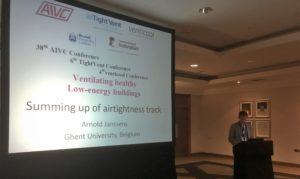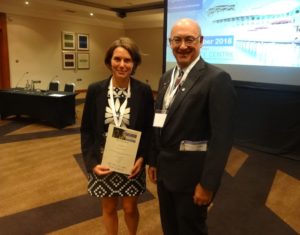Feedback from the 38th AIVC & 6th TightVent conference: Summary of the airtightness track
The airtightness track at the AIVC 2017 conference consisted of 23 presentations organised in 5 sessions of which 3 were topical sessions with a number of invited presentations. Most of the airtightness topics in the call for papers for the conference were represented in the papers in the airtightness track:
- Durability of building and ductwork airtightness
- Energy impact of envelope and ductwork leakage
- Field data and case studies
- Infiltration measurement techniques
- Design and construction approaches for airtight buildings
A topical session discussed methods to assess the durability of airtightness. The session covered field measurements, accelerated ageing in laboratory, seasonal variations and also exposure loads of the air barrier. Valérie Leprince [1] presented a comprehensive review of studies dealing with durability of building airtightness and proposed an experimental protocol for artificial ageing. Her paper won the conference best paper award. A study by the Belgian Building Research Institute quantified the effect of different types of ageing (wind load, temperature and humidity variations) on the airtightness of both masonry and wood frame walls using laboratory tests. This type of information is very relevant for building practice.
Another topical session discussed recent work to integrate uncertainties due to wind and stack in declared building airtightness results. Guidelines were presented to reduce the experimental error both in situations with low and high wind speeds (> 6 m/s). Christophe Delmotte presented the weighted line of organic correlation as a more appropriate technique to take into account uncertainties in measured air flow rates and pressure differences (e.g. at zero-flow), compared to the ordinary least squares regression technique.
Several presentations in other sessions were dealing with the development and analysis of building air leakage databases. Building airtightness testing is mandatory in the UK, France, Ireland and Denmark. Field measurement data are available in 6 European countries. Most of the time, databases are managed by testers’ qualification bodies and contain mainly data of new residential buildings. The large volume of data are used to identify trends and analyse failure rates compared to regulatory requirements or design targets for indoor air quality or energy use, as a study by the Air Tightness Testing and Measurement Association in the UK explained. The development of a new database characterising the airtightness of the existing housing stock has been launched in Spain.
Ductwork airtightness was receiving less attention than building airtightness. Adeline Bailly [3] presented a ductwork airtightness measurement scheme and database developed in France. She discussed figures regarding main characteristics of the buildings and ventilation systems in which ductwork airtightness measurements were performed, showing increasing application of tests in residential buildings.
- Leprince, V., B. Moujalled and A. Litvak. 2017. Durability of building airtightness, review and analysis of existing studies. Proceedings of the 38th AIVC Conference, Nottingham UK, 1-14.
- Delmotte, C. 2017. Airtightness of Buildings – Considerations regarding the zero-flow pressure and the weighted line of organic correlation. Proceedings of the 38th AIVC Conference, Nottingham UK, 770-779
- Bailly Mélois,A. and B. Moujalled. 2017. About 1,000 ductwork airtightness measurements performed in new French buildings: database creation and first analyses. Proceedings of the 38th AIVC Conference, Nottingham UK, 310-317.
by Arnold Janssens, Professor of Building Physics, Ghent University, Belgium


